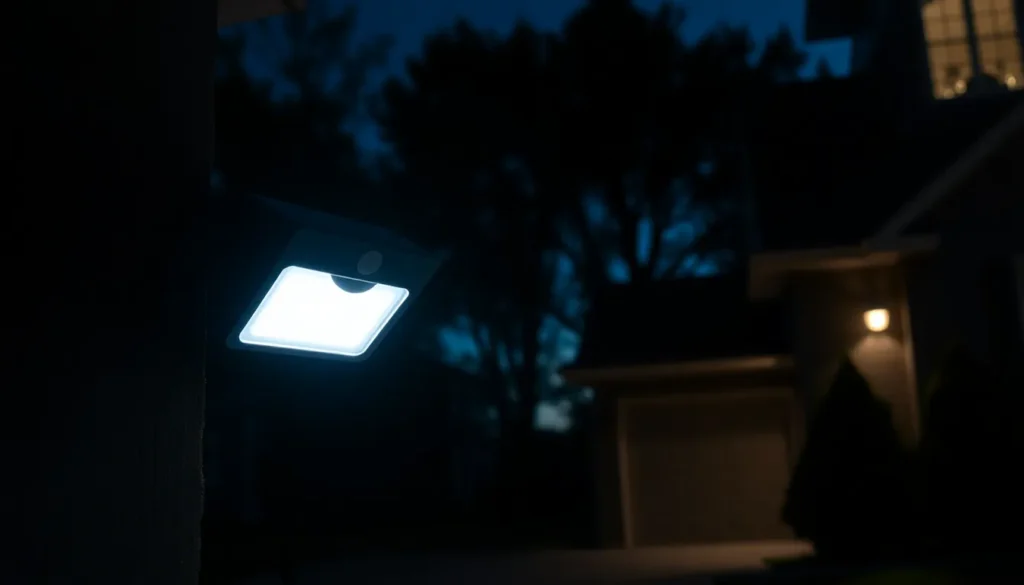Imagine walking into a dark room, arms full of groceries, and suddenly—BAM! A light flickers on, illuminating your path like a scene from a sci-fi movie. Motion-activated lights aren’t just about convenience; they’re the unsung heroes of modern living. They save energy, enhance security, and make you feel like a secret agent every time you enter a space.
These clever gadgets are perfect for anyone who’s ever fumbled in the dark, searching for a light switch while juggling a bag of chips. With motion-activated lights, you’ll never have to worry about tripping over a rogue shoe again. Plus, they add a sprinkle of high-tech flair to your home. So, let’s dive into the world of motion-activated lights and discover why they’re the ultimate upgrade for your living space.
Table of Contents
ToggleOverview of Motion-Activated Lights
Motion-activated lights serve as intuitive lighting solutions that react to movement. Many homeowners choose these devices for their blend of convenience, energy savings, and enhanced security.
What Are Motion-Activated Lights?
Motion-activated lights are lighting fixtures that turn on automatically upon detecting movement. These lights come in various forms, including wall-mounted, ceiling-mounted, and portable options. Designed for both indoor and outdoor use, they are an efficient way to illuminate areas without manual operation. Common usage areas include driveways, entrances, and backyards, where their automatic activation increases safety during nighttime. Advanced models may feature adjustable sensitivity settings to fine-tune detection capabilities.
How Do They Work?
Detection of movement triggers motion-activated lights, employing different technologies to ensure functionality. Passive infrared sensors (PIR) detect heat emitted from bodies, while ultrasonic sensors utilize sound waves for movement detection. Some models integrate both technologies for improved accuracy. Once the sensor identifies movement, an electrical signal activates the light source. Typical activation durations range from 30 seconds to several minutes, depending on individual settings. Smart models may connect to apps, allowing for customized control via smartphones.
Advantages of Motion-Activated Lights

Motion-activated lights offer numerous benefits that make them an essential addition to modern homes. Their main advantages include enhanced security and energy efficiency.
Enhanced Security
Enhanced security is a primary benefit of motion-activated lights. They deter intruders by automatically illuminating areas when movement is detected. Safety increases significantly around driveways, pathways, and entrances, where these lights provide visibility during nighttime hours. Homeowners can enjoy peace of mind knowing their property is better protected. Systems equipped with advanced sensors also reduce false alarms, ensuring reliability. Some models even integrate with home security systems, allowing for seamless alerts and monitoring. Overall, the presence of motion-activated lights creates a safer environment for families and guests alike.
Energy Efficiency
Energy efficiency plays a crucial role in the advantages of motion-activated lights. These lights turn on only when needed, minimizing unnecessary energy consumption and reducing electricity bills. By relying on sensors, homeowners gain control over their energy use, contributing to a sustainable lifestyle. Most models allow adjustable sensitivity settings, customizing activation based on specific needs. When installed outdoors, these lights activate in response to movement, ensuring illumination only during active hours. As a result, less energy waste occurs, making them a cost-effective solution for both residential and commercial properties.
Types of Motion-Activated Lights
Motion-activated lights come in various types, catering to different needs and settings. These options include indoor and outdoor lights, as well as various sensor types that enhance functionality.
Indoor vs. Outdoor Options
Indoor motion-activated lights serve different uses like hallways, living rooms, and basements. They often feature a softer glow, providing welcome illumination without being harsh. Outdoor variants, however, focus on security and visibility, ideal for driveways and entrances. Weather-resistant designs withstand elements, ensuring reliability during rain or snow. Both indoor and outdoor options contribute to energy efficiency by illuminating spaces only when needed.
Different Types of Sensors
Passive infrared sensors (PIR) detect movement through body heat, activating lights without false triggering. Ultrasonic sensors emit sound waves, detecting motion by measuring reflection changes. Dual technology sensors combine PIR and ultrasonic methods for increased accuracy, reducing the occurrence of false positives. Light sensors automatically adjust activation based on ambient light levels, enhancing functionality. Each sensor type addresses specific needs, ensuring optimal performance in a variety of settings.
Key Features to Consider
Motion-activated lights offer various features that enhance their usability and efficiency. Here are critical aspects to evaluate when selecting these systems.
Brightness and Color Temperature
Brightness levels significantly affect visibility and ambiance. Most motion-activated lights provide options ranging from 300 to 1000 lumens. The selection allows customization to fit different environments. Color temperature also plays a role, with options available from warm white (2700K) to cool white (6000K). Warmer tones create a cozy atmosphere, while cooler tones enhance alertness and security. It’s essential to choose a light temperature compatible with its intended use.
Durability and Weather Resistance
Durability ensures longevity and consistent performance. Many outdoor motion-activated lights feature weather-resistant materials designed to withstand harsh conditions. An IP65 rating or higher indicates excellent resistance to water and dust. This rating guarantees reliable operation during rain, snow, or extreme temperatures. Selecting models with robust build quality significantly enhances performance life, especially for outdoor installations. Prioritizing these factors enables homeowners to enjoy superb functionality year-round.
Best Motion-Activated Lights on the Market
Recent advancements in motion-activated lights offer homeowners numerous choices tailored for security and outdoor enjoyment. Here’s a detailed look at top options available.
Top Picks for Home Security
Some top picks for enhancing home security include the Ring Floodlight Cam and the Philips Hue Outdoor Sensor. The Ring Floodlight Cam combines high brightness with a camera feature, allowing homeowners to monitor their property remotely. An adjustable motion-detection range ensures it captures movement accurately. Meanwhile, the Philips Hue Outdoor Sensor integrates with existing smart home systems, providing customizable settings and scheduling options. For added peace of mind, these devices emit bright light upon detecting movement, deterring potential intruders effectively.
Recommended Options for Patios and Gardens
Illuminating patios and gardens calls for specialized motion-activated lights like the Mr. Beams Outdoor Motion Sensor Light and the Lazarus Solar Motion Sensor Light. The Mr. Beams light offers wireless installation, making it flexible for various outdoor settings. With a range of 30 feet, this option provides significant coverage. In contrast, the Lazarus Solar option promotes energy efficiency by utilizing solar power and features adjustable brightness settings. These lights ensure attractive ambiance while enhancing safety in outdoor areas, making them perfect for evening gatherings.
Motion-activated lights represent a significant advancement in home lighting solutions. Their ability to enhance security and energy efficiency makes them an essential addition to any property. With various options available for both indoor and outdoor use, homeowners can find the perfect fit for their specific needs.
The integration of advanced sensor technologies ensures reliable performance while minimizing energy waste. As these lights continue to evolve with smart technology, they offer even more customization and control. Embracing motion-activated lights not only simplifies daily routines but also elevates the overall safety and ambiance of living spaces.




